Services on Demand
Journal
Article
Indicators
-
 Cited by SciELO
Cited by SciELO -
 Access statistics
Access statistics
Related links
-
 Cited by Google
Cited by Google -
 Similars in
SciELO
Similars in
SciELO -
 Similars in Google
Similars in Google
Share
Revista MVZ Córdoba
Print version ISSN 0122-0268
Rev.MVZ Cordoba vol.21 no.1 Córdoba Jan./Apr. 2016
ORIGINAL
Effect of environmental factor on some litter traits of sows in the tropics Mexican
Efecto de factores ambientales sobre algunas características de la camada de cerdas en el trópico de México
Jesús Ek M,* M.Sc, José Segura C, Ph.D, Alejandro Alzina L, M.Sc.
Universidad Autónoma de Yucatán, Facultad de Medicina Veterinaria y Zootecnia, Km 15.5 carretera Mérida-Xmatkuil, AP 4-116, Mérida, Yucatán, México.
*Correspondence: jeemvz@hotmail.com
Received: May 2014; Accepted: April 2015.
ABSTRACT
Objective. To determine the effect of environmental factors on litter traits at birth and weaning, and their repeatabilities in four farms in the sub-humid tropics of Mexico. Materials and methods. Data from 46.249 to 50.316 litters for litter size at birth (LSB), number of piglets born alive (NBA), litter weight at birth (LWB), number of piglets weaned (NPW) and litter weight at weaning (LWW) were used. The statistical model for LSB, NBA and LWB included the effects of farm, farrowing year, farrowing season, parity number, simple interactions, random effects of sow and the error term. NPW and LWW were analyzed using the previous model plus the linear and quadratic effects of lactation length (LL). Results. The means for LSB, NBA, LWB, NPW and LWW were 11.7 piglets, 11.0 piglets, 16.1 kg, 10.3 piglets and 61.3 kg, respectively. All effects in the model affected the litter traits. Farrowing year x season interaction was significant for NPW, LWB and LWW. The dry season had the highest LSB, NBA y NPW. First parity sows had higher LSB and NBA means than for second parity sows. Parity increase until parity 4 to decrease thereafter. LL had a quadratic effect on NPW and LWW. Repeatability estimates for LSB, NBA, and LWB were 0.12, 0.12 and 0.14, respectively. Conclusions. All traits studied were influenced by the environmental factors studied. Repeatabilities for LSB, NBA and LWB were low.
Key words: Litter size, repeatability, reproduction, seasonal variation (Source:CAB).
RESUMEN
Objetivo. Determinar el efecto de factores ambientales sobre características de la camada al nacer y al destete, y sus repetibilidades en cuatro granjas en el trópico sub-húmedo de México. Materiales y métodos. Se utilizaron los datos de 50.316 a 46.249 camadas para el total de lechones nacidos (LSB), lechones nacidos vivos (NBA) y peso de la camada al nacimiento (LWB), lechones destetados (NPW) y peso de la camada al destete (LWW). El modelo estadístico para LSB, NBA y LWB incluyen los efectos de granja, año, época, número de parto, interacciones simples, efecto aleatorio de cerda y error. El modelo para NPW y LWW incluyó los factores anteriores y además, los efectos lineal y cuadrático de largo de lactación (LL). Resultados. Las medias para LSB, NBA, LWB, NPW y LWW fueron 11.7 lechones, 11.0 lechones, 16.1 kg, 10.3 lechones y 61.3 kg, respectivamente. Todos los factores estudiados afectaron las características de la camada. La interacción de año x época fue significativa para NPW, LWB y LWW. La época seca presentó las mayores medias de LSB, NBA y NPW. Las cerdas primer parto obtuvieron medias de LSB y NBA superiores que las cerdas del segundo parto. Las medias por número de parto incrementaron hasta el cuarto, para después disminuir. La LL obtuvo un efecto cuadrático sobre NPW y LWW. Las repetibilidades estimadas para LSB, NBA, y LWW fueron 0.12, 0.12 y 0.14, respectivamente. Conclusiones. Todos los factores ambientales estudiados afectaron las características de la camada al nacer y al destete. Las repetibilidades estimadas fueron bajas.
Palabras clave: Repetibilidad, reproducción, tamaño de camada, variación estacional. (Fuente: CAB).
INTRODUCTION
Litter size and piglet weight at birth and weaning are components of production that significantly influence the biological efficiency of sows and the profitability of farms. Hyperprolific modern sows have a high reproductive potential, which needs to be optimized according to the environmental and management conditions where they are employed. Important sources of variation in tropical regions are farm, farrowing year, farrowing season, and parity (1,2). In Mexico, there are few studies on the environmental factors affecting the size and litter weight at birth and weaning of sows in commercial pig farms under sub-humid tropical conditions (3-5). The identification of the factors affecting those components of productivity is necessary to adequate the operation, techniques and technologies of production systems. Furthermore, knowledge of the indicators is important to make better decisions, which means a better return on investment in swine production systems in tropical Mexico.
Besides foregoing, when the best sows are selected early in life, a greater gain in productivity is expected, because highly heritable traits retain that superiority over their productive lifetime. It is therefore important to measure the extent of which this is likely to happen, through the calculation of the repeatability of the trait of interest (6).
The aim of this study was to determine the effect of some environmental factors on litter traits at birth and weaning, and to estimate the repeatability of birth traits in four farms located in the sub-humid tropics of Mexico.
MATERIALS AND METHODS
Study site. Data from the four typical commercial farms of the state of Yucatan, Mexico, were used to for this retrospective study. Yucatan is located between 19°30' and 21°35' north and 90°24' west. The climate of the region is sub-humid tropical, with an average temperature of 26.6°C, an average rainfall of 1,100 mm, and a relative humidity of 78% (7).
Management in farms. Farms 1, 2 and 4 were full cycle farms with 3.900, 1.200 and 550 sows, respectively. Farm 3 was a two-site-type farm (breeding and production) with 320 sows. In all farms, breeding was carried out by artificial insemination; however if sows did get pregnant after three inseminations, natural mating with a boar was used. Estrus detection in sows was performed every day at 6:00 and 18:00 h using a boar, and inseminated two times (12-18 h), after estrus detection. Cross-fostering of piglets was carried out the first two days after birth in all farms. Sows were fed commercial diets according to their productive stage. Young sows (about 200 kg body weight) received 2.6 kg/day of feed with 3,000 kcal EM/kg, 16% crude protein and 0.8% lysine; whereas sows over 300 kg of body weight received 3.2 kg/day of feed. The four farms produced their own replacements and quarantine the replacement gilts before entering the breeding herd (approximately 24 weeks of age), and they were mated after 210 day of age. Gilt and sows were vaccinated against parvovirus, leptospirosis, swine erysipelas, mycoplasmosis, and pleuropneumonia diseases.
Animals. Data from 50.316 litters from 10.340 sows for total piglets born per litter (LSB), number of piglets born alive (NBA) and litter weight at birth (LWB), and 46.249 litters from 10.065 sows for number of piglets weaned (NPW) and litter weight at weaning (LWW) were used. Data were obtained from the computer recording system (PigCHAMP®) of the herds from 2007 to 2012. The main information used was farm name, sow identification, sow parity number, date of farrowing and weaning, litter size and weight at farrowing and weaning.
Data analysis. The statistical model used for LSB, NBA and LWB included the fixed effects of farm [1,2,3,4], farrowing year (2007,2008,..., 2012) farrowing season (dry, rainy and windy), parity number of the sow [1,2,3,4,5,6,7>8], significant simple interactions, and random effects of sow (0, σ2c) and the error NID (0,σ2e). The dry season covers the months from February to May, the rainy season from June to September and the windy season from October to January. Sows with 8 or more parities were grouped, because of small number of observations. NPW was analyzed using a model similar to that previously described, plus the linear effect of NBA and the linear and quadratic effects of lactation length (LL). The model for LWW was similar to NPW but including the linear effect of LWB instead of NBA. The statistical analyses were carried out using the MIXED procedure (8).
Repeatability estimates and standard errors were calculated only for LSB, NBA and LWB using both between and within sow components of variance produced by the MIXED procedure, according to the formula provided by Falconer and Mackay (6) and Becker (9). Repeatabilities for NPW and LWW were not calculated because of cross-foster of piglets practiced in the farms.
RESULTS
The overall means and standard deviations for LSB, NBA, LWB, NPW and LWW were 11.7±3.11 piglets, 11.0±3.02 piglets, 16.2±4.35 kg, 10.3±3.12 piglets and 61.3±20.0 kg, respectively. Lactation length had a mean and standard deviation of 22.4±2.9 days.
All the factors and interactions included in the models were significant (p<0.05) on the five response variables. The least squares means for the main factors are shown in table 1.
Table 1. Least squares means and standard errors by source of variation for total piglets born per litter (LSB), number of piglets born alive (NBA), litter weight at birth (LWB), number of piglets weaned (NPW) and litter weight at weaning (LWW) in four farms in the sub-humid tropics of Mexico.
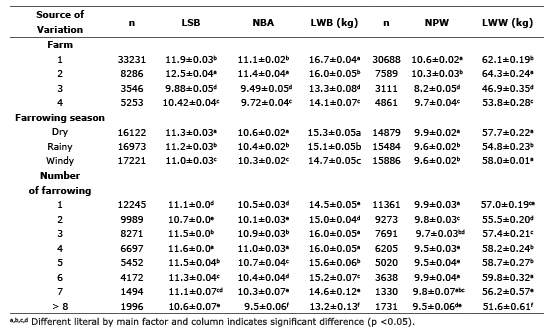
The interaction of year x season of farrowings was significant for LWB, NPW, and LWW (Figure 1, 2 and 3, respectively). The highest mean at different season vary with the year. figure 1 and 2 show no trend; with means in different seasons and years; however, figure 3 results shows a trend of increasing LWW starting in 2009. The interaction between farm and farrowing season was significant for LWB and LWW. Figure 4 and 5 show different means of LWB and LWW for farms in different season.
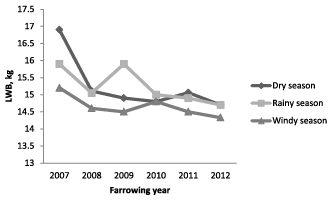
Figure 1. Year by season of farrowing interaction for litter weight at birth (LWB).
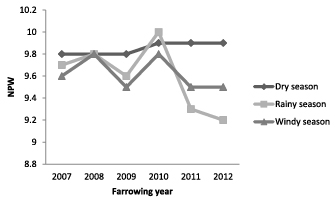
Figure 2. Year by season of farrowing interaction for number of piglets weaned (NPW).
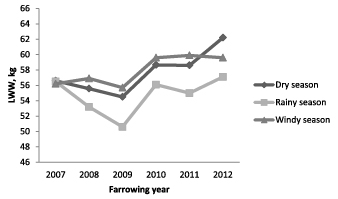
Figure 3. Year by season of farrowing interaction for litter weight at weaning (LWW).
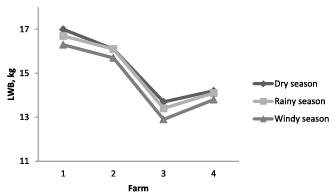
Figure 4. Farm by season of farrowing interaction for litter weight at birth (LWB).
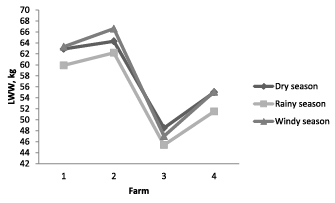
Figure 5. Farm by season of farrowing interaction for litter weight at weaning (LWW).
Farm 2 had the highest means for LSB, NBA and LWW; farm 1 had the highest means for LWB and NPW; and farm 3 had the worst performance. The dry season had the highest LSB, NBA, LWB and NPW, and the rainy season the lowest LWW. First parity sows had higher LSB and NBA than second parity (p<0.05), to increase thereafter until fourth parity and then decreased in the following farrowings. The highest LWB was obtained in farrowings 3 and 4, and the largest NPW was found in both farrowings 1 and 6; the largest LWW was found in sows of parity 6.
Lactation length has negative linear (-1.3±0.056), and positive quadratic (0.037±0.001), effects on NPW, and positive linear (3.22±0.27) and negative quadratic (-0.012±0.005) effects on LWW. Positive linear effect of NBA (0.014±0.004) and positive linear effect of LWB (0.14±0.019) on NPW and LWW respectively.
The repeatability estimates and standard errors for LSB, NBA, and LWB were 0.13± 0.004, 0.12± 0.004 and 0.14±0.004, respectively.
DISCUSSION
The overall means and standard deviations for LSB and NBA were lower than those reported by Abell et al (10) in USA (14.8 and 11.6 pigs, respectively). However, the means here found are higher than mean reported by Diaz et al (11) in Colombia, who obtained 10.8 pigs for NBA. The LWB mean was similar than the mean reported by Chansomboon (1) in Thailand with 16 kg, and higher than those reported by Fraga et al (12) in Brazil and Gourdine et al (13) in Guadeloupe with 15.0 kg and 14.0 kg, respectively. Schwarz et al (14) reported a lower NPW mean (8.4 pigs) in Polish Large White sows. Also, Chansomboon et al (1), Diaz et al (11) and Gomez-Medina et al (5) reported means of 8.57, 10 and 9.44 pigs, respectively. The LWW mean here found is lower than that reported by Gourdine et al (13); however it is similar to the 60.8 kg reported by Sai et al (15). The differences in mean values may be due to geographical location, management and application of differences technologies, and commercial breeds used, as well as population structure and the presence or not of diseases in farms.
The effect of farm on litter traits at birth and weaning has been reported by other authors (1,16,17). Farm differences primarily involves the skills and training of staff, housing systems, genetics of the reproductive herd, number of sows, average number of farrowing and implementation of reproductive and feeding techniques provided to the sow in the area of farrowing and lactation.
Effect of farrowing year has been reported for LSB and NBA (2,16,17). Causes of the differences between years studied in this work are difficult to explain but might be attributed to different management conditions, differences in climatic conditions or staff experience in sows management.
The interaction of year by season of farrowing was significant for LWB, NPW and LWW, similar to the results reported by other authors, under tropical conditions (1,18,19). The differences for LWB and NPW could be due to management and sanitary differences between seasons and years (Figure 1 and 2). Additionally, appropriate management practices can improve LWW, the trend of increasing LWW might be due to increasing feed intake. However, the rainy season showed lowest means of LWW in all years (Figure 3). The combination of high temperature and high humidity during the rainy season has been reported to be partly associated with reduced appetite (17). According to Chambonson et al (1) the interaction is the result of the combined effects of nutrition (nutritional content and composition of diets), climate (seasonal fluctuations in humidity and temperature), and management during the different years.
The effect of season or month on LSB and NBA in tropical regions has been reported by other authors (2,5,16,17,18). Suriyasomboon et al (17) and Tummaruk et al (2) indicate that in the tropics regions the effect of season is due to the high environmental temperature, high humidity, and to a lesser extent to changes in the photoperiod. Negative effect of high ambient temperature affects reproductive traits of sows, either by acting directly on ovarian function or to the hypothalamic-pituitary-ovarian axis level (17). Also, in tropical areas such as Thailand and Brazil, Suriyasomboon et al (20,21) and Freneau et al (22) indicate that the high temperatures have a significant negative effect on ejaculate volume, total sperm counts and the morphology of the spermatozoa of the boars.
Table 1 shows a decrease in LSB and NBA from first to second parity, a phenomenon known as the syndrome of the second litter, which has been reported by other authors (23,24). Hoving et al (24) and Schenkel et al (25) indicate that the reduction in litter size after the first farrowing is probably due to a lower rate of ovulation and to an increase in embryo mortality because gilts are more susceptible to lose weight during lactation and have not finished their corporal development yet. First farrowing females with larger NBA may have not enough feed intake during lactation to fulfill their nutritional requirements, so that embryonic survival (and subsequent litter size) in these females is reduced.
The effect of parity number on LSB and NBA has been reported by other authors (2,16,17,26). Also, the effect of parity number on LWB, NPW and LWW has been reported by Tantasuparuk et al (18) and Chansomboon et al (1). The usual increase in litter size up to parity 4 is probably due to the increase in ovulation rate, uterine capacity and age of the sow (27).
Estimated repeatability for LSB is slightly lower than that (0.14) reported by Nguyen et al (28); whereas repeatability for NBA is lower than the 0.27 estimate reported by Adeoye et al (29) in native pigs in Nigeria, which is similar that reported by Segura et al (30) under the same conditions of the current study (0.12); however, is higher than the repeatability estimate (0.09) found by Nguyen et al (28). The repeatability here estimated for LWB is higher than that (0.11) reported by Adeoye et al (29), but equal to that (0.13) reported by Segura et al (30). According to Segura et al (30) the difference between repeatability estimates may be due to differences between breeds or genetic commercial lines, environmental conditions and management and statistical methods used. The repeatability means of estimated in this study were low suggesting that to improve these characteristics is more important to improve the management that to use genetic methods.
In conclusion, under the conditions of this study, all the environmental factors studied were important sources of variation for all litter traits at birth and weaning. Therefore all of them should be considered in production programs to improve management strategies and herd feeding in order to reduce the effect of both season farrowing and number parity to improve farm's productivity and profitability. Repeatability estimates were low but within the values reported in the literature.
REFERENCES
1. Chansomboon C, Elzo MA, Suwanasopee T, Koonawootrittriron S. Estimation of genetic parameters and trends for weaning-to-first service interval and litter traits in a commercial landrace-large white swine population in northern Thailand. Asian-Aust J Anim Sci 2010; 23:543-555. [ Links ]
2. Tummaruk P, Tantasuparuk M, techakumphu M, Kunavongkrit A. Seasonal influences on the litter size at birth of pigs are more pronounced in the gilt than sow litters. J Agri Sci 2010; 148:421-432. [ Links ]
3. Segura CJ, Segura CV. Influencia de algunos factores genéticos y ambientales sobre la eficiencia reproductiva de cerdos en una granja de la Chontalpa, Tabasco. Vet Méx 1991; 12:73-76. [ Links ]
4. Chimal P, Segura JC. Estimates of breed average direct, maternal and heterosis effects for some productive traits of swine in the Mexican tropics. Rev Brasil Genet (Brazil J Genetics) 1994; 17:267-271. [ Links ]
5. Gómez-Medina M, Segura-Correa J, Rodríguez-Buenfil J. 1999. Efecto de año, bimestre y número de parto de la cerda en el tamaño y peso de la camada al nacer y al destete en una granja comercial. Rev Biomed 1999; 10:23-28. [ Links ]
6. Falconer DS, Mackay TFC. Introducción a la genética Cuantitativa. 4a ed. Zaragoza, España: Editorial Acribia, S.A. 2006. [ Links ]
7. Instituto Nacional de Estadistica y Geografia (INEGI). Anuario Estadístico de los Estados Unidos Mexicanos 2010. Aguascalientes, Ags: INEGI; 2010. [ Links ]
8. SAS Institute Inc.®: Guide for Personal computer [programa de ordenador]. Versión 9.2. Cary (NC): SAS Institute IC.; 2008. [ Links ]
9. Becker WA. Manual of Quantitative Genetics. 5th Ed. Pullman, Washington: Academic Enterprises; 1992. [ Links ]
10. Abell CE, Mabry JW, Dekkers JCM, Stalder KJ. Genetic and phenotypic relationships among reproductive and post-weaning traits from a commercial swine breeding company. Livest Sci 2012; 145:183-188. [ Links ]
11. Díaz C, Rodríguez N, Vera V, Ramírez G, Casas G, Mogollón J. Caracterización de los sistemas de producción porcina en las principales regiones porcicolas colombianas. Rev Colomb Cienc Pecu 2011; 24:131-144. [ Links ]
12. Fraga AB, Araújo F, Azevedo AP, Silva F, Santana R, Machado D, et al. Peso médio do leitão, peso e tamanho de leitegada, natimortalidade e mortalidade em suínos no Estado de Alagoas. Rev Bras Saúde Prod An 2007; 8:354-363. [ Links ]
13. Gourdine JL, Quesnel H, Bidanel J, Renaudeau D. Effect of season, parity and lactation on reproductive performance of sows intropical humid climate. Asian-Aust J Anim Sci 2006; 8:1111-1119. [ Links ]
14. Schwarz T, Nowicki J, Tuz R. Reproductive performance of Polish Large White sows in intensive production-efect of parity and season. Ann Anim Sci 2009; 3:269-277. [ Links ]
15. Sai PJ, Gnana PM, Gupta BR, Mahender. Genetic study on reproductive traits in crossbred pigs. Liv Res Rural Develop [en línea] 2009; (acesso 26 de febrero de 2013) 21(9). URL Disponible en: http://www.lrrd.org/lrrd21/9/pras21142.htm. [ Links ]
16. Tummaruk P, Tantasuparuk W, Techakumphu M, Kunavongkrit A. Effect of season and outdoor climate on litter size at birth in purebred Landrace and Yorkshire sows in Thailand. J Vet Med Sci 2004;66:477-82. [ Links ]
17. Suriyasomboon A, Lundeheim N, Kunavongkrit A, Einarsson S. Effect of temperature and humidity on reproductive performance of crossbred sows in Thailand. Theriogenology 2006; 65:606-628. [ Links ]
18. Tantasuparuk W, Lundeheim N, Dalin AM, Kunavongkrit A, Einarsson S. Reproductive performance of purebred Landrace and Yorkshire sows in Thailand with special reference to seasonal influence and parity number. Theriogenology 2000; 54:481-96. [ Links ]
19. Pholsing P, Koonawootrittriron S, Elzo M, Suwanasopee T. Genetic association between age and litter traits at first farrowing in a commercial Pietrain-Large White population in Thailand. Kasetsart J Nat Sci 2009; 43:280-287. [ Links ]
20. Suriyasomboon A, Kunavongkrit A, Lundeheim N, Einarsson S. Effect of temperature and humidity on sperm production in Duroc boars under different housing systems in Thailand. Livest Prod Sci 2004; 89:19-31. [ Links ]
21. Suriyasomboon A, Kunavongkrit A, Lundeheim N, Einarsson S. Effect of temperature and humidity on sperm morphology in Duroc boars under different housing systems in Thailand. J Vet Med Sci 2005; 67:777-785. [ Links ]
22. Freneau GE, Ferreira JD, Sobestiansky J. Avaliação das caracteristicas seminais de varrões mantidos em centrais de inseminação artificial com ambiente climatizado e não climatizado durante 12 meses. Ci Anim Bras, Goiânia 2012; 4:466-478. [ Links ]
23. Saito H, Sasaki Y, Hoshino Y, Koketsu Y. The occurrence of decreased numbers of pigs born alive in parity 2 sows does not negatively affect herd productivity in Japan. Livest Sci 2010; 128:189-192. [ Links ]
24. Hoving LL, Soede NM, Graat EAM, Feitsma H, Kemp B. Reproductive performance of second parity sows: Relations with subsecuente reproduction. Livest Sci 2011; 140:124-130. [ Links ]
25. Schenkel AC, Bernardi ML, Bortolozzo and Wentz I. 2010. Body reserve mobilization during lactation in first parity sows and its effect on second litter size. Livest Sci 210; 132:165-172. [ Links ]
26. Ordaz-Ochoa G, Juárez-Caratachea A, García-Valladares A, Pérez-Sánchez E, Ortiz-Rodríguez R. Efecto del número de parto sobre los principales indicadores reproductivos de las cerdas. Revista Científica FCV-LUZ 2013; 23:511-519. [ Links ]
27. Foxcroft GR, Dixon WT, Novak S, Putman CT, Town SC, Vinsky MD. The biological basis for prenatal programming of postnatal performance in pigs. J Anim Sci 2006; 84 Suppl:E105-112. [ Links ]
28. Nguyen NH, McPhee CP, Wade CM. Genetic variation and responses in reproductive performance of sows in lines selected for growth rate under restricted feeding. Anim Sci 2006; 82:7-12. [ Links ]
29. Adeoye AA, Adeogun IO, Akinokun JO. Repeatability of litter traits of Nigerian indigenous sows. Liv Res Rural Develop (en linea) 2003; (fecha de acceso 26 de febrero de 2013) 15:1-6; URL disponible en: http://www.lrrd.org/lrrd15/2/adeo152.htm. [ Links ]
30. Segura CJ, Alzina A, Ek JE, Segura VM. Estimadores de índices de constancia para características de la camada al nacimiento e intervalo entre partos de cerdas utilizando aproximaciones de máxima verosimilitud restringida y bayesianas. Revista Científica, FCV-LUZ 2013; 23:54-58. [ Links ]













